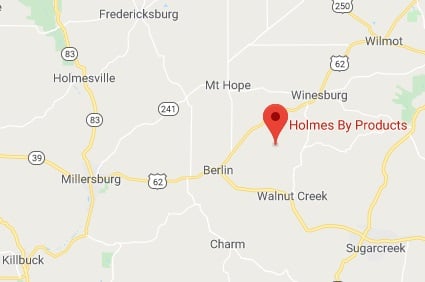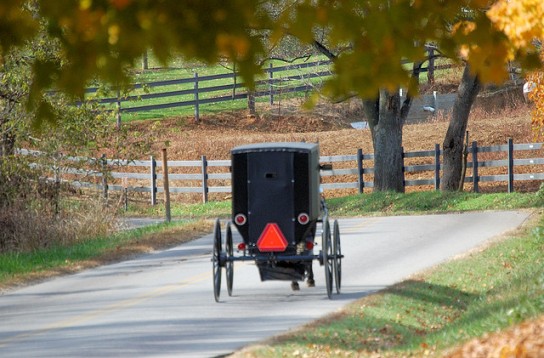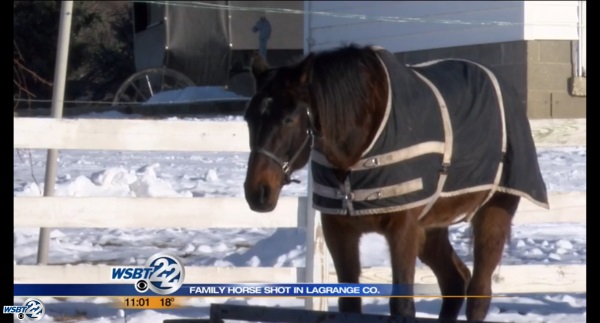Amish Plea For Help In Face Of Rendering Plant Stench (Updated)
Amish residents near Berlin, Ohio have been complaining about the odors emanating from a local rendering plant for some time.
They’ve now been given an outlet to do so formally – and have taken advantage of it.
An “odor hotline” has received around 450 complaint calls since being set up in July.
The complaints are going against a local business called Holmes By Products, which converts food processing waste into animal feed.
Now the Ohio EPA is investigating.
I have experienced the smell of this place (locally known as “the stink plant”), and it is absolutely awful. Stomach-turning – I don’t know how people live in that area. I suppose you…get used to it?

I’ll admit I have a more sensitive nose than most. Regardless, I have heard complaints from Amish who live in the general vicinity of this place.
A report in the New Philadelphia Times-Reporter further details the foul effects of the plant’s stench, via a local Amish taxi driver:
Larry Wilgus, a Berlin resident, said the Amish community is tired of the foul odor. He serves as a driver for Amish residents.
“So I hear the pleas for help every day of the week to get this ‘stink’ under control,” Wilgus said. “It becomes a real hardship when Amish get sick, throw up, take medication, lose sleep, and Amish women have to re-wash their laundry when the pungent odor settles in their clean clothes and in their homes during the summer months.”
I’m sure it doesn’t help property values either. I imagine that if the smells were more noticeable in the tourist center town of Berlin, action may have been taken more quickly on this.
Wilgus says that the EPA has been “wimpy and evasive.” He explains that there are 40 Amish informants who report the foul odor.
Rendering plant use technologies such as “scrubbers” and thermal oxidizers to control odor. Still, as you might imagine, these odors can be tough to extinguish.

A rendering plant has to go somewhere. They perform a valuable service in the animal processing industry. This one has been around since 1958, when the county had about half its present population.
Maybe there is a more isolated area that would be more suitable for a plant like this. Or maybe boosting whatever odor-fighting technology they are using would be a solution.
Of course, smell is going to be an issue in rural areas. Amish people know this better than most.
Animals live in the countryside. Fertilizers and other agricultural products don’t smell so nice. The air is not going to be perpetually scented with rose petals.
Still, there are rural smells that are more bearable than others. Cows on dairy farms create an odor, but one that is not nearly as offensive (some dairy dwellers might even consider it mildly pleasant).
I’d consider air to be a common good. A business or private individual ought to bear some responsibility for the harm which soiling the air causes to neighbors.
I would put rendering plants up there with two other sources – poultry farms…and Decatur, Illinois (home to agrocorporation ADM, whose processing plant creates an absolutely awful stench) as the most foul-smelling places I’ve ever encountered.
So the local residents have my sympathy and support, for whatever that is worth.
I’m also wondering what exactly follows an EPA investigation?
If found in violation of some sort of norms, would the plant need to improve its operations? More powerful scrubbers and oxidizers? Would it be in danger of being shut down?
Update: I probably should have included in this post a comment in the original article from a Holmes County commissioner: “Commissioner Joe Miller said many of the complaints to the hotline are coming from the same individual.”
I was also emailed yesterday by someone I know in Holmes County who told me something similar: “this is one man that’s complaining”.
This might seem to contradict the idea that there are 40 Amish informants actively calling in complaints.
On the other hand, if it’s just a single individual, we can do a bit of math: we know the complaint hotline was set up in July, but we don’t know the exact date. So let’s make it July 1, the earliest possible date in July. That would make 112 days from July 1 to October 21, the date this article was published.
If he were responsible for all of the calls, that would mean roughly one person calling the same hotline about 4 times per day (450 calls/112 days= 4.017).
I’d assume he is not calling on Sundays, so that would make that average even higher.
Is a single person calling 4 times a day since July?
Maybe he is responsible for “many” of the calls, but “many” could mean, say, 50 or 100 calls. Or let’s even say he’s made a majority of the calls, over 225. Any of those figures could qualify as “many” and could mean he has made far more than the other callers on average. But, there would still be a significant number of other callers.
In any case, I don’t think it invalidates the idea that local residents in general dislike the odors created by this plant. We’ve got a couple who’ve commented on this post, and I have also linked to a couple of others within the post. Without further concrete details, how many are actually calling, and how many calls the referenced “heavy-calling” individual is actually responsible for, is open to speculation.









Plant ( process) for pet foods
I’ve lived around and or near these , and there aren’t very many things that can be done because the smells mostly come from vent stacks .
A better filtering system should and could be the solution.
Mount Pleasant Texas is a big chicken plant area , they have the same problems at certain times of the year , it has gotten better over the years .
You may look into how other industry standards and best practices are met thru the natural evolutionary process of technology.
Pilgrim Pride corporation is the main company in our area .
Stink plant in Holmes County, OH
Updated air scrubbers and thermal oxidizers would solve the problem. Call Commissioner Joe Miller 330.204.1490 to add your support to clean up the air. All Americans deserve the right to breathe fresh air 24/7.
rendering odors
It sounds like a maintenance cleaning is in order.
Contact the OHIO state health inspector not the EPA.(Federal)
If it can be done. Ask the plant to only render on specific days.
New technology is available for air scrubbers.
Stink plant in Holmes County, OH
No one in Holmes County seems to know what to do to curtail this offensive odor – especially affecting the Amish. Call Commissioner Joe Miller 330.204.1490 by lending support to find a solution. The “stink” has been going on for 60 years.
EPA Odor Hotline update
500+ calls have now been registered with the OH EPA Holmes County Odor Hotline. The putrid odor and freguency hasn’t changed. Support our efforts to bring relief by calling Kristopher Weiss at OH EPA and leave a comment 614.644.2160 Thank you.
Analogous to the Tyrone, Penna. Papermill.
Reminds me of a papermill town down in the hills of Penna. that I used to somewhat regularly pass through.
Tyrone, Penna. used to have a very active papermill, and oh boy! the stink
that emanated from the papermill was awful.
I can well imagine that the odor from the rendering plant would be much akin to the the odors from the Tyrone papermill.
I hope the Amish are able to get some positive action taken to reduce to minimal levels the odors that emanate from the rendering plant.
Good you brought up paper mills Richard. I’m familiar with the smell of a paper mill – my father grew up in a small NC town which had a Weyerhaeuser plant. It’s definitely not a pleasant smell, but in my opinion nowhere near as bad as a rendering plant. I would gladly trade one for the other if I were in the situation of the Holmes County locals in this story.
meat processer stench
Mr. Holmes, Paper mill odors output have changed over the years due to a required change in the chemicals used in the process. Also, the energy released were re processed as fuel source for the paper plant.
Hill shire in New London, WI was able to counteract the odor issues as well as Johnsonville. Can additional funding be obtained to assist is the cost incurred to resolve the issue of this particular facility?
Help save the planet too
If we all had mostly a plant-based diet this issue could be rendered! –or greatly ameliorated—
Stink plant in Holmes County, OH
The odor from Holmes By-Products is offensive to many of the Amish living in the wind of the stink plant. The putrid odor travels 1-14 miles away from the plant into all the small townships. You can help us enforce the need to correct this issue by calling Commissioner Joe Miller 330.204.1490
Stink plant in Holmes County, OH
Because the stink plant has been in operation for 60 years, most Amish have learned to endure the putrid odor, but hate it. The local commissioners and state officials claim they can’t do anything about it, so that’s why I got the Ohio EPA involved. Commissioner Joe Miller 330.204.1490 needs to hear from you to voice your support to find a solution.
How many people have been calling the hotline?
Hi Larry, thanks for your comments. You referenced 40 Amish who are “odor informants” in the original article – could you comment if those 40 have all been actively calling, or if not all of them, how many you would estimate have called?
I ask this because one of the Holmes County Commissioners, as well as someone I know in Holmes County, suggest that many of the calls are coming from one individual (see my update to the post above).
However, it seems like that would be a lot of calls for one person to be responsible for over just 3-4 months’ time. Any additional info you can share is appreciated.
Stink plant in Holmes County, OH
Commissioner Joe Miller is trying to downplay the significance of 450+ calls to the EPA Holmes County Odor Hotline. There is no way I could have made even 1/5 of the calls. Amish are getting up the boldness to finally say they have had enough of this putrid odor. Please call Commissioner Miller and leave a voice message 330.204.1490 The frequency and sharpness of the odor hasn’t changed. All Amish have a right to breathe fresh air 24/7.
May not be "just one man"
I don’t know how the commissioner has determined that all the calls are coming from one man. But if they are tracking phone numbers then the commissioner is dumber than dumb because anybody that knows anything about the Amish knows they have phone shacks that everybody in the community shares. So even if most of the calls are coming from the same # it could be any # of different people using that phone to complain.
I personally have stopped and used random phone shacks from time to time when my cell phone had no signal, but I needed to make a call.
Amish Plea For Help
You can personally call and leave a voice message with Commissioner Joe Miller 330.204.1490 and tell him it’s impossible for one person to make the majority of calls. Calls are coming in from all over Holmes County.
Stink plant in Holmes County, OH
Mandatory requirements have been ignored for 60 years in Holmes County. The law and rules approved by the Ohio legislatures 8-10-1994. Ohio Law and Rules Chapter 953: RENDERING PLANTS
953.25 Disposal or rendering of raw rendering material requirements.
(A) In the disposal or rendering of raw rendering material, all of the following requirements shall be met:
(1) All raw rendering material shall be processed or disposed of within forty-eight hours after its arrival at the rendering plant;
(2) Each cooking vat or tank shall be airtight, except for proper escapes for steam;
(3) Steam shall be disposed of so as to cause no nuisance
So, what’s going on with Holmes County politics?
EPA Odor Hotline update
520 calls have now been registered with the OH EPA Holmes County Odor Hotline. Nothing has changed. We still smell the putrid odor.
Larry, what is the current status here? Is the Ohio EPA still investigating? Have there been any further reports?
Stench Plant
I suppose it comes down to who was there first. I been involved with such issues with trains and their whistles. If the plant was involved in stench production (rendering) before the locals move in or built their homes, the locals should have known what to expect. If the farms were there first the plant needs to provide a fix. The rendering company could offer a to buy land that’s down wind, which is what they should have done to begin with, or pay the farmers for their inconvenience in addition to air pollution fines. My guess is that in previous years the stench wasn’t bad but due to larger production volumes or changes in the process the stench level has multiplied. In that case the company should be required to fix it or move it.
Stink plant
If this place gets shut down, how will we know it’s gonna rain within 24 hours ♂️
We always get to smell it and live ten miles away. I don’t see how anyone can live close by that place
Stink plant in Holmes County, OH
If you don’t want to smell the stink again, please call the EP Holmes County Odor Hotline. You’ll talk to a message machine. 330.425.9171
If you want to let Commissioner Joe Miller know your frustration with the stink, call him 330.204.1490 and leave a message.
EPA Odor Hotline update
The EPA is tracking the odor by satellite. It is critical that you call every day anytime you smell the putrid odor. Call 330.425.9171 and leave a message on the recording. Thank you.
I live not far from the “stink plant” and weirdly enough, it’s more annoying smell-wise to some people living further away than we do. It’s not that we got used to it, probably more to do with wind patterns or elevation??? When we DO smell it, it’s horrible and we rush to shut windows and if we happen to be eating outside (as we like to do in the summer), there’s a mad dash for the house and a decreased appetite. It really is disgusting. We kind of accepted it as one of those things you just have to endure.
But this article was in our local paper last Sun. and it was the first I realized there WAS a number to call or that anything might be done about it. I quickly put the phone # in our phone shack on a sticky note saying “Stink Plant Hotline” and I’ll make use of it the next time we gag on the stench.
Stink plant in Holmes County, OH
Your call to the EPA Odor Hotline is critical in getting something done. Please call that number – anytime you smell this offensive odor. The EPA is keeping track of the calls from all over Holmes County. You can call everyday if necessary to report the odor again. Also, leave a voice message with Commissioner Joe Miller 330.204.1490 who has been ignoring this issue for years and years. We want something done!
Who Was There First?
While I feel that the company should do what it can as far as employing available technology to mediate the odors, I have a tough time sympathizing with the complaints of people who make the choice to move into an area where such a processing plant has been long-established.
The plant HAS been there a long time, but it has also gotten much worse. A lot of the people who live in the immediate area around it were born & raised there, often with several generations on one farm.
Well technically the Amish...
Glywn that point generally would resonate more with me – do your homework before you make a big decision like where you’re going to buy a home, etc. – but as Yoder says the smell has gotten much worse, which could suggest that they’ve expanded operations/output over the years, or that previous anti-smell measures have declined in effectiveness.
The other thing is that the Amish have lived in that area since 1808. So we could turn the “who was there first” argument against the plant.
When the plant was opened in 1958, there were already dozens of Amish congregations in the area, and the trajectory of this settlement after 150 years in Holmes County was pretty well set.
If it’s mainly Amish – who tend to settle in the same area as their extended families and stay on farms for generations as Yoder says – who are affected, I can understand the complaints. Moving is of course possible, but those roots run deep.
meat processor stench.
Attached are the mandatory requirements.
http://www.miga.org/sites/default/files/archive/Documents/MeatProcessing.pdf
What about contacting a state university?
https://ehs.osu.edu/node/16/done?sid=1306&token=ac85aff3b3cf7707b6e2291a683a6f98
Used the phone # today
It’s a damp, mist morning and the smell is strong. Yuck.
Stink plant in Holmes County, OH
I trust you called the OH EPA Holmes County Odor Hotline 330.425.9171 to report the stench. Everybody in your neighborhood needs to call. Please pass the word and phone number.
Stink plant in Holmes County, OH
Did you call Commissioner Joe Miller 330.204.1490 to let him know of your disgust about the horrible smell?
Used the phone # today
You can call the odor hotline anytime of the day or night because you talk to a answering machine. Examples: you can call later today and report you smelled the stench at 9:30am. You can call Sunday and report you smelled the stench Saturday at 10am.
EPA Odor Hotline update
500+ calls have been registered with the OH EPA Holmes County Odor Hotline. The EPA is tracking the odor by satellite and calls to a recording are our only course of response at this time. PLEASE call everytime you smell the putrid odor to a message recording 330.425.9171 THANK YOU.
I called and reported it.
meat processor
If you moved there knowing it was in the area, you should have no complaints. Instead of whining about it, help them to find a solution. I already suggested that this be used by the OHIO State U and a teaching opportunity for their senior students. Contact them for assistance. Sit down with company members to seek resolution.
Ask how you can help them! Stop whining about it.
You moved there. You can move out.
With the assistance of a congressman, seek funds to provide to the MS or PhD students at the university.
Amish Plea For Help
Lisa – I have appealed to the OH EPA who remind me that the issue is under investigation. At this stage, we have no other choice but to call and register a complaint with the odor hotline. The rendering plant says they are in compliance with the EPA, but we find fault in their answer by looking at the laws and rules of rendering plants in Ohio.
rendering plant
Larry,
Again I suggest working with the local university and their health and science programs. Typically, they have their students work on a resolution project. I am familiar with air scrubbers and their manufacturing.
Consider asking a Wright Patterson AFB environmental division if they are aware of any other alternatives in cleaning the air. I know they have tactical personnel to address Chem bio events. But, it would advantageous to have a congressman to forward the request for assistance.
Advanced hospitals also have the appropriate knowledge bank. Contact OSHA association office for assistance. PFMA is another association.
Look not at the problem, look at a potential solution as well as the funds for the solution.
Landscapeprofessionals,
Landscapeprofessionals, yet another fantastic value based article based on research, and i think all the tips are the result of learning through experience, that’s why they are so much valuable for the readers of top 5 lawn and landscape trends.